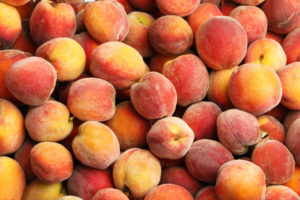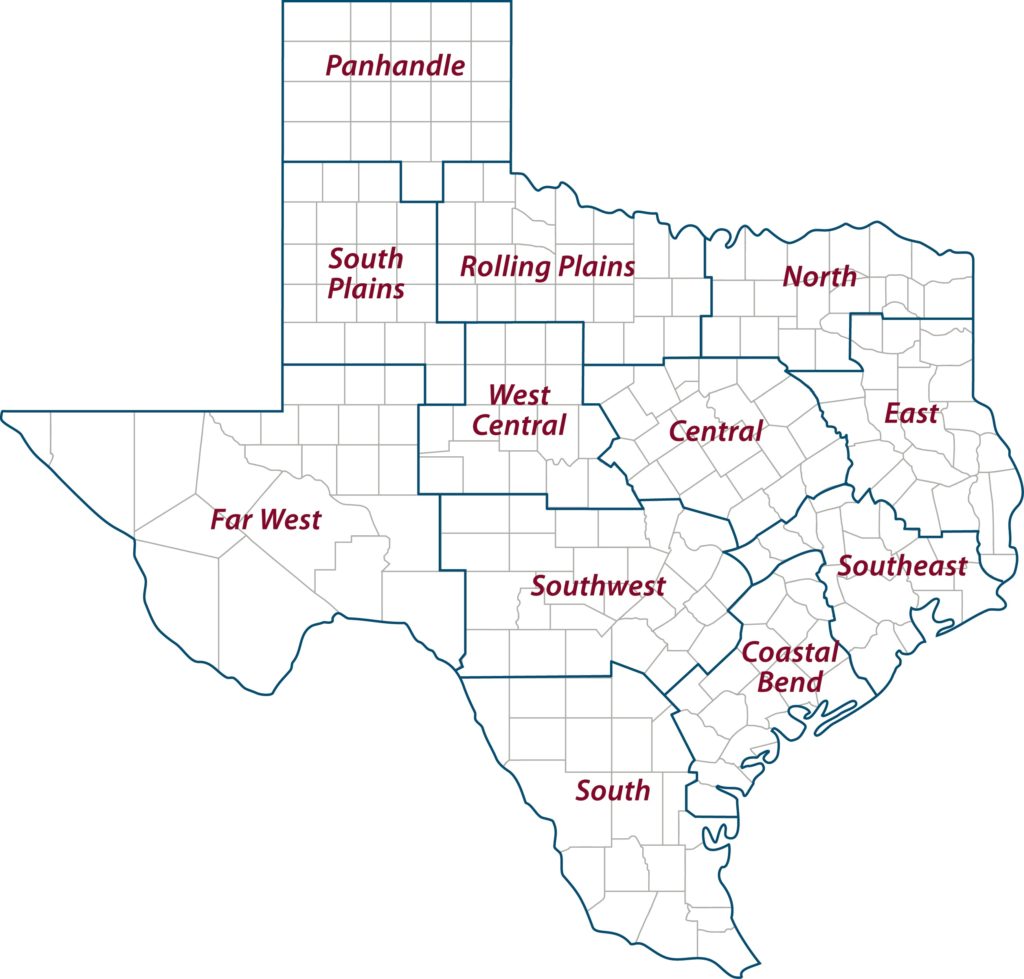Texas producers expect bumper peach, blackberry crops
Texas Crop and Weather Report – May 18, 2021
Texas peach and blackberry producers are reporting above-average fruit sets, good growing conditions and very few issues as they near harvests, and are expecting high demand, according to a Texas A&M AgriLife Extension Service expert.

Larry Stein, Ph.D., AgriLife Extension horticulturist, Uvalde, said there was fear among growers that Winter Storm Uri might impact Texas peach production significantly, but all signs point to an above-average crop. Blackberries, another significant fruit crop for the state, were also expected to produce a bumper crop.
“I wasn’t sure there would be a crop this year, but barring any unforeseen weather calamities, Texas producers are expecting a good crop in both quality and quantity,” Stein said.
Conditions have been good overall since the freeze for Texas’ fruit crop, Stein said. Dry conditions helped trees avoid disease issues, and timely rains have provided good additional moisture as fruit begins to fill out. So far, spring storms have produced minimal hail and turbulent winds that can cause yield loss.
While some early peach varieties and trees actively emerging from winter or that had opening blooms suffered crop loss and some tree damage or kills, Stein said Texas’ commercial production orchards fared well. But it will likely be next year before producers truly know the extent of any tree damage suffered during Winter Storm Uri.
“The extent of tree tissue injury is the only unknown,” Stein said. “Will those injuries be significant? When the heat sets in, will they still be able to transfer moisture? If not, we could see some more dead trees, but I think most trees that made it through the freeze and set fruit are showing signs that they are OK.”
Peach crop progressing
Stein said the Texas peach crop continues to progress and that producers are expecting a good year. Availability should be good, but demand and prices are expected to be higher than normal.
“The peach crop looks amazingly good,” he said. “There were some fruit set losses on trees with actively growing buds, but trees with tight buds came through the cold fine and are progressing nicely. Producers should do well because demand will be very high, and consumers should expect good, quality fruit.”
Some early fruiting varieties in South Texas and varieties grown in high tunnel houses in the Hill Country are ripening and should be available soon, Stein said.
He said trees were behind on chill hours due to warmer than normal temperatures prior to the winter storm, but that the cold and cooler temperatures since provided orchards more than enough to trigger good blooms. Good, cold winters tend to push better blooms and fruit sets, but the best chill hours occur between 32 degrees and 45 degrees.
Winter Storm Uri provided limited chill hours, as extreme, sub-freezing temperatures during that week were not conducive to chill, Stein said.
If anything, he said, producers’ thinning efforts will factor heavily in the yield and quality of individual orchards.
“The only challenge this year might be adequate thinning to get proper fruit size,” Stein said. “There is a fine balance that producers must find that will allow trees to produce that marketable-sized peach, but still maintain a good yield.”
Thinning fruit set is also critical to a tree’s long-term production cycle, Stein said. Leaving heavy fruit loads on trees can stress them, which sets them up for a poor performance next year or makes them susceptible to diseases like canker.
“Over-thinning is better than under-thinning,” he said. “It can be a gamble because you never know what weather will do, but it’s better for fruit quality in the near-term and for the tree in the long-term.”
Notable blackberry crop
Stein said peaches aren’t the only Texas fruit crop expected to experience a bumper year. Blackberries appear to have exceptional fruit sets this year, and some areas in South Texas are already harvesting some varieties.
Blackberries have always been a popular supplemental crop for peach growers, but new thornless varieties are making the fruit a considerable crop, especially for “pick-your-own” orchards, Stein said. Selecting the right variety for individual locations and having enough water to allow fruit set to make plump berries are all that growers need most years for success with them.
“Most peach people have small patches of blackberries scattered throughout their orchards,” he said. “The acres aren’t high, but these newer varieties coming out may change the game.”
AgriLife Extension district reporters compiled the following summaries:
CENTRAL
Soil moisture levels continued to improve. The emergence of cotton and forage grasses and replanted corn were excellent. Pastures looked good, and livestock were doing well. Stock tanks were filling somewhat. Winter wheat and oats that suffered freeze damage filled well. Most winter wheat turned color and was maturing rapidly. Susceptible oats were showing signs of loose smut. Corn and sorghum were developing nicely. Some Stewart’s disease was showing in susceptible corn along field border areas. Many producers cut and baled their ryegrass. Forecasts called for wetter-than-normal conditions over the next couple of weeks.
ROLLING PLAINS
Beneficial rains fell in areas. Stock tank and pond water levels improved. Pasture conditions were improving. Wheat harvest started in some areas.
COASTAL BEND
Conditions were cool and windy with up to 3 inches of rain reported in some locations. Recent rain was somewhat detrimental to some cotton, especially where drainage was poor or fields were standing in water. Weeds could be a problem for some cotton fields. Windy conditions continued to limit herbicide applications. Corn was tasseling, silking and doing well. Sorghum was beginning to head out in some areas. Rice producers were through planting and most of the crop had emerged. Producers were busy cutting and baling hay. Insecticide applications for first generation pecan nut casebearer were also active prior to weekend rainfall with only light infestations reported. Rangeland and pasture conditions continued to improve with adequate soil moisture. Livestock were doing well. Mosquitoes were a problem.
EAST
Rainfall totals were around 10 inches or more, and much of the district was thoroughly saturated. Sabine County reported flash flooding, tornadoes and high winds. Houston County reported washed-out roads. Heavy rains put a halt to hay production. More rain and thunderstorms were forecasted. Pasture and rangeland conditions were fair to good. Subsoil and topsoil conditions were adequate to surplus. Fertilizer prices were still on the rise. Livestock were fair to good with supplemental feeding taking place. Horn flies and heel flies were reported. Feral hogs continued to cause damage to pastures and hay meadows.
SOUTH PLAINS
Weather was cooler with scattered rain across the district, but drought conditions remained. The cooler weather delayed cotton planting, which should resume as warmer temperatures return. Many farmers were prewatering fields before planting. Cattle were grazing winter wheat, and pastures were starting to green up across the county.
PANHANDLE
Northern and central areas reported short to adequate moisture levels. Pastures and rangelands were in very poor to fair condition. Rangelands were greening up in areas with better moisture. Winter wheat condition was poor to good. Oats were in fair condition. Producers were planting corn, chopping silage and laying wheat and triticale down for hay.
NORTH
Most counties reported surplus on soil moisture due to heavy rains that included some hail. Pastures were saturated, which was delaying hay harvest. Warmer temperatures were in the forecast. Crops and grass were growing rapidly.
FAR WEST
Daytime temperatures ranged from the mid-80s to upper 70s with nighttime lows in the upper 40s. Scattered showers fell throughout the district but delivered only trace amounts of measurable rainfall. Grasses started greening, and pastures were beginning to improve. Beef cattle were in overall good condition. Winter wheat was being baled for hay. A few fields were planted, but most farmers continued to prepare fields for peanut, cotton and sorghum plantings. Weeds and feral hogs were a problem in croplands. Pecan producers were monitoring for pecan nut casebearers and watering their orchards. Producers were shipping some lambs and continued to feed livestock and wildlife.
WEST CENTRAL
No report.
SOUTHEAST
Some areas held standing water after receiving heavy rains with more precipitation in the forecast. Walker County reported good growing conditions. Several windy days impacted some vegetable producers. Rice was in excellent shape, but some fields were growing very uneven. Rice planting was still not finished, and some very late rice plantings were expected due to wet fields. Pastures received much-needed moisture. Rangeland and pasture ratings ranged from very poor to excellent with good ratings being most common. Soil moisture levels ranged from very short to surplus with adequate levels being most common.
SOUTHWEST
Pasture and rangeland conditions were improving with rainfall received across the district. Fertilized hay fields looked good, and cuttings may begin by the end of the month. Wheat harvest should be starting soon. Weed control and fertilization applications were ongoing. Most gardens were doing well. Gillespie County reported lower cattle prices, but that sheep, goats, hay and grain prices were up. Spring shearing continued. Livestock were in fair to good condition. Wildlife were in good condition, and a few early fawns were spotted.
SOUTH
Many counties received rainfall that improved soil moisture conditions. La Salle County reported 0.6-2.5 inches of rainfall this reporting period while Live Oak County reported 2-9 inches over the last 10 days. Willacy County reported up to 6 inches and flooding in low areas. Zapata County reported up to 3 inches of rainfall, Jim Wells County reported 2-4 inches, Duval County reported 1 inch and Jim Hogg County reported up to 1.5 inches for the week. Some areas remained very dry. Growing conditions were favorable in some areas. Vegetable production was underway. Wheat harvest and peanut planting were delayed by rain in some areas, but wheat and oat harvest continued in other areas. Sweet corn harvest began while grain corn was beginning to tassel or silk. Some irrigated corn was lodging. Cotton planting was complete in many areas. Cameron County reported cotton was squaring in a small number of acres. Grain sorghum was beginning to head out. Hay producers were making hay and were hoping dryland meadows would respond well to rain. Strawberry production was winding down. Pecan orchards received rainfall, and producers were monitoring for pecan nut casebearer. Wildlife should benefit in areas that received rainfall. Mesquite and cactus spraying were underway in Atascosa County. Despite rainfall in some areas, burn bans remained in effect. Livestock tanks were filling, and creeks and rivers were flowing. Pasture and rangeland conditions depended on soil moisture. Some areas rebounded dramatically with green growth, but some areas remained in poor shape with supplemental feeding continuing for livestock. Many producers were fertilizing hay fields. Cattle producers continued to cull herds as feed and hay prices continued to rise. Round hay bales were $80-$100. Irrigated farmers were producing bales of Coastal Bermuda grass. Irrigated watermelons and cantaloupes continued to progress, and rains helped supplement irrigation needs. Sunflowers were blooming. Onions were 80% harvested. Winter vegetables were mostly harvested. Citrus trees continued to slowly improve. Sugarcane harvest continued.



